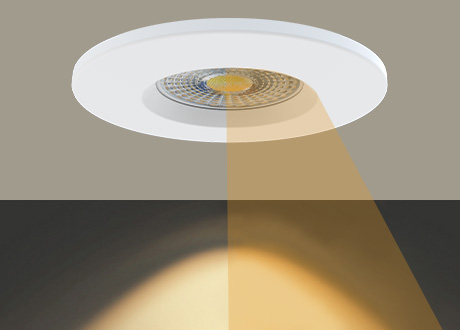How to Choose the Right Color Temperature for Different Spaces
 A-ONE
A-ONE
 Oct 10,2025
Oct 10,2025

Lighting in modern homes does more than just brighten a room. It affects our mood, health, and quality of life. Choosing the right color temperature is key to creating a human-centric lighting plan. This approach mimics natural light to support our body’s biological and circadian rhythms. Picking the wrong color temperature can ruin a space’s look and disrupt sleep, causing fatigue or low mood. This article explains how to select the ideal color temperature for different spaces to make your home lighting more scientific and comfortable.
What is CCT?
CCT, or Correlated Color Temperature, measures a light’s color in Kelvin (K), from warm yellow to cool blue. It ranges from 2700K to 6500K.
why is CCT important?it affects how colors look and how we feel. This is key in home lighting to create different atmospheres.

Types of color temperature
Color temperatures fall into three main types, each with unique effects and uses. Knowing them helps match lighting to a space’s needs.
Warm light
Warm light (2700K-3000K) has a soft, yellowish glow, like traditional incandescent bulbs or candlelight. It feels warm and relaxing, perfect for cozy settings. It boosts reds and oranges but may feel dim for tasks needing sharp focus.
Neutral light
Neutral light (3500K-4000K) is close to natural daylight, neither too warm nor too cool. It’s versatile, ideal for daily activities, and shows colors accurately without distortion. It’s a safe, balanced choice.
Cool light
Cool light (5000K-6500K) has a blueish tone, like midday sunlight or fluorescent lights. It’s bright and energizing, boosting alertness, but too much can feel harsh or uncomfortable.
These types aren’t fixed rules—consider the space’s purpose and your preferences.

Which color temperature for each space?
The function of a space determines the best color temperature. Here are recommendations based on ergonomics and real-world examples for a harmonious home.
Living room
The living room is for family time. Use warm light (2700K-3000K) for a cozy, chat-friendly vibe or neutral light (3500K-4000K) for reading or TV without eye strain.
Dining room
Choose warm white light (3000K-3500K) for the dining room. It enhances food colors, making meals look tastier and improving the dining experience, as studies show.
Bedroom
The bedroom is for rest, so stick to warm white light (2700K-3500K). It reduces blue light, supports melatonin production, and promotes deep sleep.
Kitchen
Kitchens need clear visibility. Go for cool light (4000K+) or neutral light (3500K-4000K). Cool light highlights details for cooking and cleaning, minimizing shadows.
Bathroom
Use neutral light (3500K-4000K) or cool light (4000K-5000K) in bathrooms. These provide true color rendering for tasks like makeup or shaving and keep the space bright.
Bonus
Matching color temperature to interior styles color temperature should suit the room’s style.
- Neo-Chinese style prefers warm light (2700K-3000K) to highlight wood’s warmth.
- Japandi style uses warm white light (3000K-3500K) for calm simplicity.
- Creamy style favors warm light (2700K-3000K) for a soft vibe.
- Modern style suits cool light (5000K+) to emphasize clean lines and a techy feel.

Risks of choosing the wrong color temperature
Picking the wrong color temperature can cause long-term issues. Here are common problems:
- Sleep disruption: using cool light (5000K+) in rest areas suppresses melatonin, leading to trouble sleeping or insomnia.
- Lower productivity: warm light (below 2700K) in workspaces can make you drowsy, reducing efficiency.
- Eye strain: high color temperature (6000K+) with strong blue light can cause eye fatigue or dry eyes, potentially harming the retina over time.
These risks highlight the need for smart lighting choices.
Related products
Adjustable color temperature products are increasingly popular. A-ONE’s product range offers options from cozy warm white light to crisp cool white light, meeting diverse needs. They also provide custom color temperature services to match your preferences or design. A-ONE is dedicated to creating the perfect lighting experience.
Product showcase
- Light color easily switches between cosy 2700K, warm 3000K, neutral 4000K, and cool white 5700K–6500K.
5W-7W IP65 Fire-Rated LED Fixed Downlight Dimmable with 4xCCT DL190


Fire Rated Titlable LED Downlight 6W 3CCT


Adjustable color temperature design
Manual DIP switches let you set the light’s color temperature using binary code. It’s simple, reliable, and needs no software or remote.
So why make a choice?
Choosing the right color temperature depends on understanding a space’s function, style, and human needs. Use warm tones for living rooms and bedrooms, cooler tones for kitchens and bathrooms, and warm white for dining to enhance appetite. The right choice improves lighting, aesthetics, and health. The wrong one can cause harm. Light shapes your home’s mood—choose wisely for a comfortable experience.


 Home
Home What High Luminous Efficiency Doesn't Tell You ?
What High Luminous Efficiency Doesn't Tell You ? 


 2F, Building 2, Zhongda Industrial Park, Dongshan Industrial Street, Zhangmutou Town, Dongguan, Guangdong 523619, China
2F, Building 2, Zhongda Industrial Park, Dongshan Industrial Street, Zhangmutou Town, Dongguan, Guangdong 523619, China










